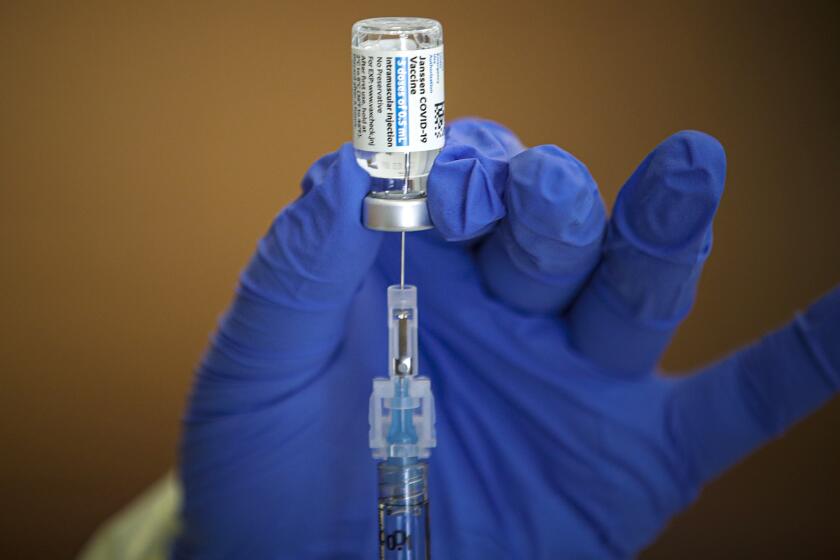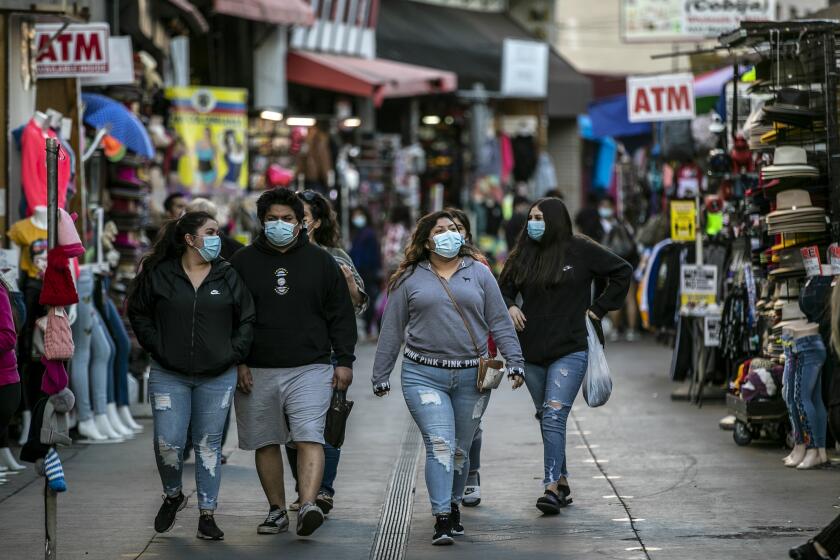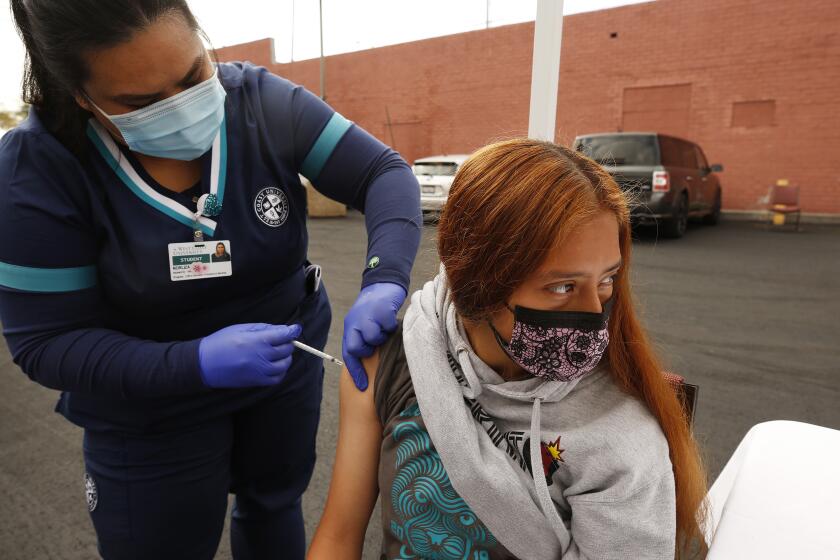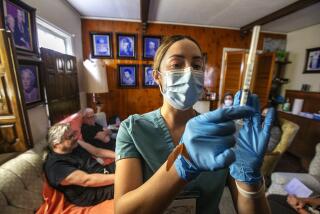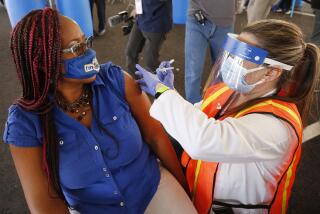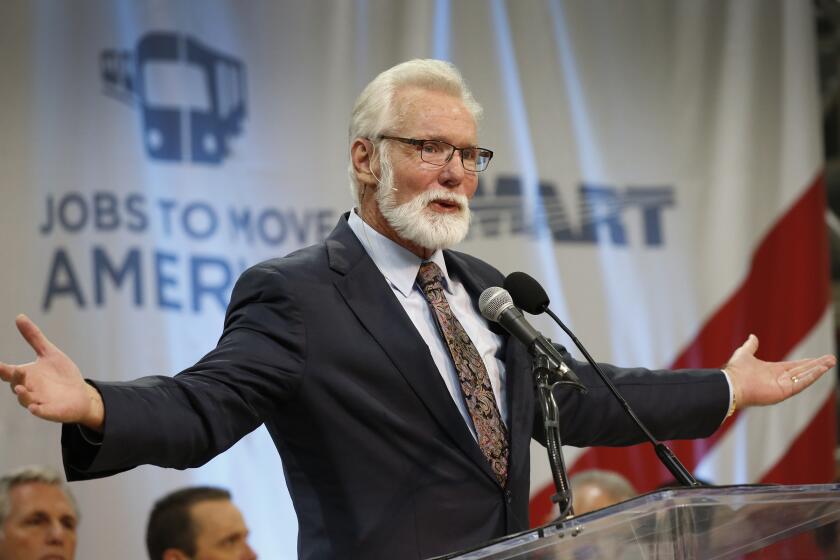L.A. County expected to hit COVID-19 herd immunity by end of July
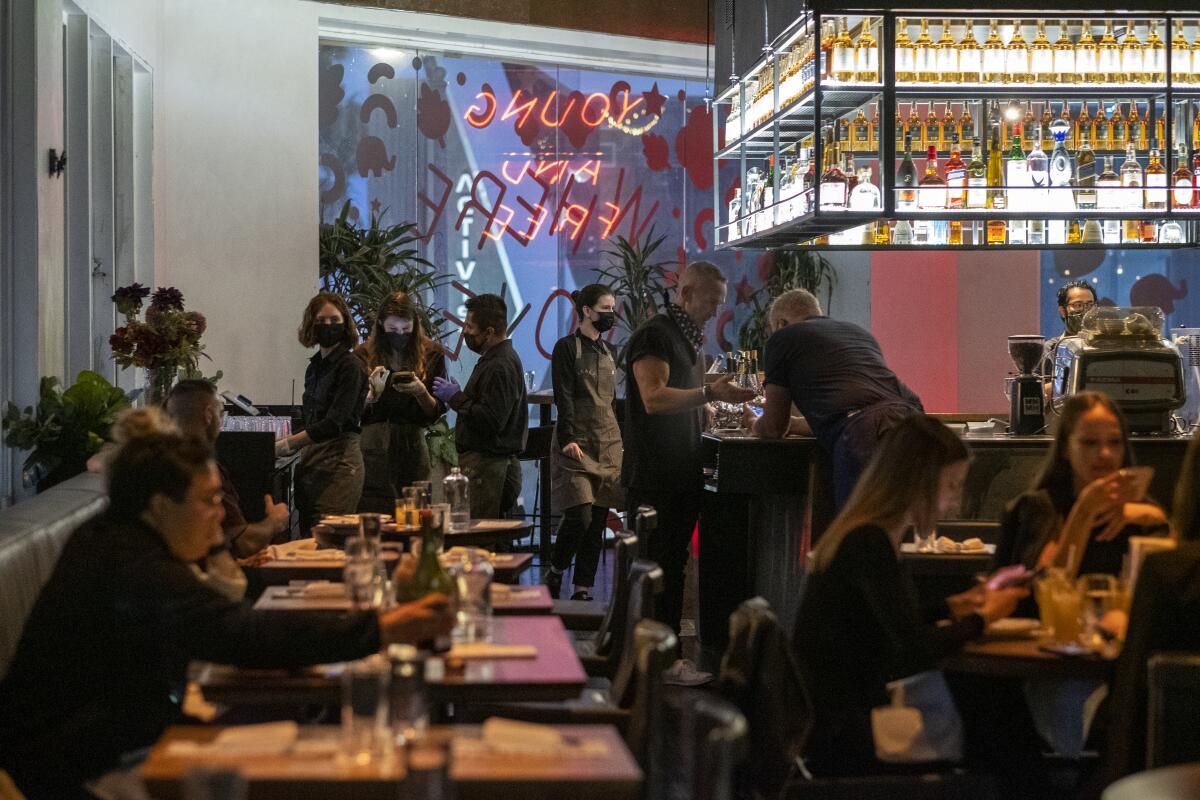
- Share via
Los Angeles County could reach herd immunity from the coronavirus among adults and the oldest teenagers by mid- to late July, another milestone that underscores the region’s rapid recovery from the pandemic.
Herd immunity, sometimes referred to as community immunity, occurs when enough people have been inoculated or have obtained natural immunity to protect the larger population against the virus.
Experts had previously expressed concern that waning demand for the COVID-19 vaccines and uneven vaccination rates could make it hard to reach that goal.
With about 400,000 shots administered weekly, the county has about 2 million first doses to go before 80% of all residents 16 and older will have received at least one shot, Los Angeles County Public Health Director Barbara Ferrer said in a news briefing Monday.
“At the rate we’re going, we expect that we can reach this level somewhere in mid- to late July, and that assumes that we continue to have at least 400,000 people vaccinated each week that will include both first doses that people need, as well as their second doses,” Ferrer said.
Ferrer noted that the estimated population that needs to be vaccinated in L.A. County for herd immunity is a guess, “but we do assume it’s probably somewhere around 80%.”
President Biden’s latest goal is to get 70% of adult Americans with at least one shot of vaccine by July 4, a target that his chief medical advisor, Dr. Anthony Fauci, said would probably result in a sustained decline of new coronavirus cases nationally. Fauci has previously guessed that 70% to 85% of a population would need to be inoculated for herd immunity to be reached.
More than 3 million people have received at least one vaccine dose, Ferrer said, and 84% of those have received their second dose on time (7% received their second doses late, and 9% have not received their second dose).
“The focus from here on in for us is to make it as easy as possible for eligible residents to get vaccinated,” Ferrer said.
The prediction comes amid growing signs COVID-19 is fading in California. The state recorded its lowest hospitalization rate since the first few weeks of the pandemic, according to data reviewed by The Times.
The numbers come just months after the fall and winter surge left hospitals across Southern California overwhelmed with patients and caused a spike in deaths.
California is hiring 2,000 canvassers to phone-bank and knock on doors, and is running a flurry of ads and testimonials about COVID-19 vaccines.
But over the last three months, COVID-19 has receded rapidly across the region, allowing a massive reopening of the economy and the hope for a return to some kind of normality by the summer.
California is now close to the bottom of the nation when it comes to coronavirus case rates over the past week. Los Angeles and San Francisco counties last week progressed into the least-restrictive tier of California’s color-coded closure system.
Officials in some parts of the Bay Area said they could soon reach herd immunity soon as well.
Dr. George Rutherford, an epidemiologist at UC San Francisco, said he thought the Bay Area region would experience some form of herd immunity first — perhaps by mid-June or early July — followed by urban and suburban Southern California sometime later, with agricultural California coming after that.
But that’s all contingent on vaccine rates remaining steady and not declining more steeply than they have recently.
Even after the CDC said fully vaccinated Americans could stop wearing masks outdoors unless they’re in a crowd of strangers, many in L.A. still mask up.
There are now more than 750 sites offering vaccinations in Los Angeles County, including pharmacies, clinics, community sites and hospitals. Many are concentrated in areas with lower levels of community health, which have been hit hard by the pandemic, Ferrer said.
“We want to make it super easy to get a vaccine if you live in these communities,” she said, noting that 185 mobile vaccination teams are also working to reach people who may have limited ability or time to get to one of the established vaccination sites.
Residents can obtain vaccines at the eight county-run sites, all the L.A. City-run sites, almost all mobile sites and many of the community sites without an appointment, Ferrer said. Many are open on weekends and have evening hours.
CVS, RiteAid and Walmart locations nationwide are offering vaccines without requiring an appointment, subject to availability. L.A. County is also increasing its capacity to bring vaccine clinics to workplaces, and people will soon be able to request the county to come to their worksite to administer vaccines.
“The strategy right now is to pop up wherever people are already gathering,” Ferrer said, adding that people can visit VaccinateLACounty.com or call (833) 540-0473 to find a nearby site.
Of L.A. County’s 10.1 million residents, 8.3 million are 16 and older. As of Friday, 4.89 million adults and older teenagers in L.A. County had received at least one dose of COVID-19 vaccine, about 59% of this population.
L.A. County’s goal of getting 80% of adults and the older teens vaccinated doesn’t account for vaccinating adolescents 12 to 15 — who on Monday became eligible to be vaccinated with the Pfizer vaccine — nor younger children.
But the 80% goal among those eligible for the vaccine is a reasonable guess for reaching herd immunity, Ferrer said.
After all, while children do get sick from COVID-19 and can transmit the virus, “children tend to be not as efficient spreaders as older teens and as adults are,” Ferrer said. “The more and more people that get vaccinated, the less and less there’s going to be community transmission.”
“We do need to work harder to ensure that there’s good information and easy access to vaccinations for our younger people,” L.A. County Public Health Director Barbara Ferrer said.
To get more people immunized, L.A. County will still need to confront disparities among certain demographics who have been less likely to get vaccinated: Latino and Black residents, young people and men.
Among the county’s adults and older teens, 60% of white, 68% of Asian American and 58% of Native American residents have received at least one dose of vaccine. But only 38% of Black and 42% of Latino residents in this age group have received one dose.
Teenagers and the youngest adults are also less likely to have received a shot. The majority of adults in their 30s and older have received one shot, but among the youngest adults — up to age 29 — only 45% have received at least one dose of vaccine, and among 16- and 17-year-olds, only 34% have gotten at least one shot.
And while 62% of eligible female residents of L.A. County have received at least one vaccine dose, only 56% of men have.
L.A. County Supervisor Hilda Solis said the county is working to improve access to the vaccine and is considering ideas such as hosting vaccine clinics in sports venues where young people are already going. Solis also urged role models to speak publicly about the need to get vaccinated, and family members and friends to reach out to their loved ones.
“We still have a long way to go,” she said.
There were some signs of optimism. Ferrer said she was working Saturday at the vaccine site at Eugene A. Obregon Park in the predominantly Latino neighborhood of East L.A., and 60% of the people that came in were male.
“They were bringing their friends, and they were frankly happy to be there and felt like it was important for them to come in and get vaccinated,” Ferrer said. “But we made it a lot easier at that site: You don’t need an appointment, and that site is in the middle of a community that many people can walk to or take a bus to.”
And in Los Angeles, Mayor Eric Garcetti said the city’s Mobile Outreach for Vaccine Equity program — which operates its own mobile vaccine clinics and is run by the mayor’s office and Fire Department — has administered more than 100,000 doses in neighborhoods hard hit by COVID-19.
”A person’s ZIP code or neighborhood should never be a barrier to accessing life-saving vaccines, and this week’s milestone is a reflection of our commitment to putting shots into the arms of Angelenos no matter where they live,” Garcetti said in a statement.
Overall, 90% of first doses administered by the city’s mobile vaccine clinics have gone to people of color, with about two-thirds of them going to Latino residents.
In the Bay Area, Santa Clara County this week plans to host three nights of “student vaccination nights” at Levi’s Stadium, where the 49ers play, providing drop-in vaccine clinics for students 16 to 19 and their families.
Santa Clara County — Northern California’s most populous — also is reporting low vaccination rates among teens, with only 40% of 16- and 17-year-olds getting at least one dose, compared to 73% of all eligible residents.
“That has to be the strategy moving forward because ... if we’re not successful, we delay the point at which we get to community immunity,” Ferrer said of L.A. County’s plans.
More to Read
Sign up for Essential California
The most important California stories and recommendations in your inbox every morning.
You may occasionally receive promotional content from the Los Angeles Times.
